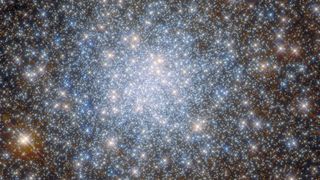Hubble Space Telescope captures photo of a dazzling star cluster
Hubble has a long history with globular clusters.

Sure, the Webb telescope is getting most of the attention these days — and it should. It's a monumental achievement!
But the James Webb Space Telescope's predecessor, the Hubble Space Telescope, is showing us why it shouldn't be forgotten.
NASA and ESA, who co-manage Hubble, have just released a new spectacular image of globular cluster NGC 6638, a star cluster in the constellation Sagittarius. The image was created from observations by Hubble's Wide Field Camera 3 and the Advanced Camera for Surveys.
Related: The best Hubble Space Telescope images of all time!
Prior to Hubble, it was nearly impossible to discern the individual stars in a globular cluster, which is a dense collection of ancient stars numbering in the tens of thousands to millions. Because ground-based telescopes have to peer through the Earth's atmosphere in order to see the stars, their view can sometimes become distorted.
That's less of an issue for Hubble, which orbits Earth at 340 miles (547 kilometers) above the surface. By comparison, Webb is about 1 million miles (1.5 million kilometers) from Earth, far beyond though it primarily operates in the infrared spectrum, while Hubble operates in the visible-light spectrum.)
That means Hubble is technically located within the atmosphere, which extends out 6,200 miles (10,00 kilometers). In fact, it's even close enough that astronauts can visit to perform repairs. (Or at least they could when the space shuttle flew.) But Hubble is located at a point in which the atmosphere is so thin that it doesn't obscure the observatory's view of the stars.
Get the Space.com Newsletter
Breaking space news, the latest updates on rocket launches, skywatching events and more!
As such, Hubble has been instrumental in globular cluster research, and it continues to make new discoveries regularly.
While Hubble is already more than 30 years old, the telescope still has quite a bit of life left in it, and scientists will continue to use it in conjunction with the James Webb telescope to answer the biggest questions about the cosmos.
The new image was released on Aug. 1.
Follow Stefanie Waldek on Twitter @StefanieWaldek. Follow us on Twitter @Spacedotcom and on Facebook.
Join our Space Forums to keep talking space on the latest missions, night sky and more! And if you have a news tip, correction or comment, let us know at: community@space.com.

Space.com contributing writer Stefanie Waldek is a self-taught space nerd and aviation geek who is passionate about all things spaceflight and astronomy. With a background in travel and design journalism, as well as a Bachelor of Arts degree from New York University, she specializes in the budding space tourism industry and Earth-based astrotourism. In her free time, you can find her watching rocket launches or looking up at the stars, wondering what is out there. Learn more about her work at www.stefaniewaldek.com.
